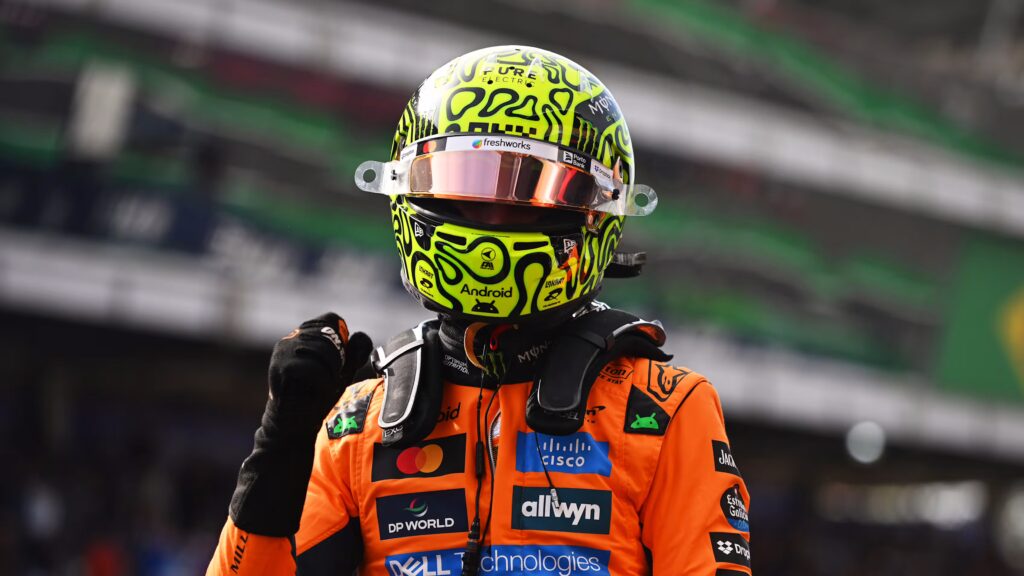
Sprint qualifying at Interlagos delivered another chaotic and entertaining Friday, with storylines ranging from strategy blunders to redemption arcs and even an unexpected chemistry lesson. Lando Norris claimed pole for the Sprint, continuing a run of form that now feels inevitable, while Kimi Antonelli stunned with a late charge to P2 ahead of Oscar Piastri.
McLaren in Control, Title Picture Shifting
Norris’ session was pure control, fast in every competitive segment, even as others struggled for consistency. Piastri looked closer through the early runs but faded just enough for Norris to lock down the top spot, cementing McLaren’s grip on the title narrative. Fans debated whether free practice performance had misled expectations, but by the end of SQ3, few doubted the difference in composure between the two.
That difference has serious implications for the championship fight. Piastri’s slump through the mid-season has stripped away his earlier advantage; Brazil was supposed to be the tracks where he could rebuild momentum. Instead, Norris looks more comfortable than ever, his confidence feeding a McLaren that’s visibly sharper on both setup and strategy.
The Titanium Dioxide Phenomenon
Antonelli’s run from almost being knocked out in SQ1 to P2 became an instant highlight, and the revival of the ongoing “Titanium Dioxide” joke among fans. His pace resurgence outside Europe has fueled a running gag correlating his form to countries where the additive remains legal. Between memes about chemistry and comparisons to NBA “strip club stats,” the teenager’s growth has been impressive in its own right. Inconsistency remains, but flashes of raw pace like this point to genuine top-tier potential.
Mercedes celebrated the front-row result with humor of their own, leaning into Antonelli’s youthful image. Beneath the jokes, though, was the quiet realization that their young driver is starting to look frighteningly capable under pressure.
Ferrari Chaos, Again
Elsewhere, Ferrari’s weekend unraveled almost as soon as it began. Both drivers fell within a tenth of each other all session, clear evidence the car, not the drivers, was the limiting factor. Leclerc’s spin in SQ2 triggered yellow flags that wiped out several flying laps, leading to confusion and anger across the paddock. Hamilton’s lap was compromised, while others narrowly escaped.
The frustration boiled over on Leclerc’s radio (“For f**k’s sake… and penalty for Stroll or whoever that Aston was”), though the stewards found no further action necessary. The exchange sparked another wave of “typical Ferrari Friday” sentiment, despair mixed with gallows humor. Even fans who defended the team’s season-long operational improvements admitted the pattern remains exhausting.
Williams and Red Bull: Same Problems, Different Scale
For Williams, Sprint Qualifying was another case study in poor execution. Carlos Sainz fought the car and traffic all through SQ1, furious that he’d been released into a congested queue, leaving him unable to get the tires into the right window. Liam Lawson’s elimination told a similar story, quick in practice, undone by miscommunication and mistimed push laps.
Red Bull, meanwhile, faced the opposite problem: a car too low, too stiff, too aggressive. Verstappen’s description of the RB21 as a “pogo stick” summed it up. The car bounced through Interlagos’ compression zones, echoing the same bottoming issues seen in FP1. The team appears to have gambled on a low-downforce setup aimed at Sunday’s dry forecast, leaving the Dutchman struggling through the twisty second sector. His visible irritation, always a reliable barometer, suggested a long weekend ahead.
Still, the broader tone around Verstappen remained one of respect. Even if out of position in P6, fans noted that he’s carrying his team in the constructors and still performing like a champion. His duel with the McLarens continues to define the season, even when the results lean against him.
Aston Martin’s Quiet Progress
Aston Martin quietly slotted both cars into the top seven, Alonso fifth, Stroll seventh, a result that felt understated compared to their messy form in recent months. The AMR25 seemed to thrive in the twistier middle sector, with both drivers praising the balance despite the car’s drag-heavy tendencies.
Fans noticed a pattern: Aston remains unpredictable, strong on high-downforce tracks but struggling for aerodynamic efficiency elsewhere. Yet seeing Alonso briefly top SQ2 and Stroll outqualify Leclerc reignited some long-dormant optimism. Small glimpse into 2026, we hope. El Plan lives.
Grid and Undercurrents
The final Sprint grid set the stage for a fascinating Saturday: Norris, Antonelli, Piastri, Russell, Alonso, Verstappen, Stroll, Leclerc, Hadjar, and Hülkenberg rounding out the top ten.
Below that, another mix of frustration and humor defined fan sentiment, from “Stroll goat” jokes to discussions of Hamilton’s continued Sprint misfortunes. Even McLaren’s dominance couldn’t mute the mix of sarcasm and admiration that defines the F1 discourse at this stage of the season.
Outlook
As rain looms and setups diverge, Saturday’s Sprint could swing wildly depending on who guessed the weather right. McLaren’s clean execution gives them the upper hand, but Red Bull’s low setup gamble and Mercedes’ rising form mean the top five could reshuffle in moments.
If anything, Interlagos once again reminded everyone why it’s a fan favorite: unpredictable, emotional, and always a little unhinged, just like the memes about titanium dioxide.
